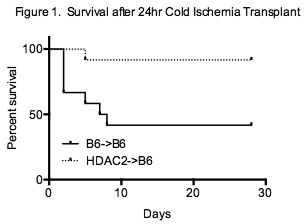Reciprocal Effects of HDAC1 and HDAC2 Deletion on Renal Cold Ischemia Survival and Nuclear Co-Repressor Complex Expression.
1Surgery, University of Pennsylvania, Philadelphia, PA
2Pathology and Laboratory Medicine, University of Pennsylvania, Philadelphia, PA
3Pathology and Laboratory Medicine, The Children's Hospital of Philadelphia, Philadelphia, PA.
Meeting: 2016 American Transplant Congress
Abstract number: C100
Keywords: Kidney, Kidney transplantation, Renal injury, Warm ischemia
Session Information
Session Name: Poster Session C: Ischemia Reperfusion Injury and Organ Preservation
Session Type: Poster Session
Date: Monday, June 13, 2016
Session Time: 6:00pm-7:00pm
 Presentation Time: 6:00pm-7:00pm
Presentation Time: 6:00pm-7:00pm
Location: Halls C&D
Introduction: Class I histone/protein deacetylases (HDACs) 1 and 2 bear >85% protein sequence homology and conventionally are thought to have similar function via occupancy in nuclear co-repressor complexes. Deletion of HDAC2 has been shown to mitigate renal warm ischemia-reperfusion injury (IRI) in mice.
Methods: Wild type C57BL/6 (WT) and whole animal-inducible HDAC1- or 2- gene deleted mice (HDAC1KO and HDAC2KO) were used in this study. Standardized warm renal IRI consisted of unilateral clamping of the renal pedicle and contralateral nephrectomy. Standardized cold IRI was achieved through procurement from gene-deleted or control mice, controlled 24 hr interval of cold storage in UW solution, and transplantation.
Results: HDAC1KO mice had impaired IRI tolerance compared to B6 controls with higher daily BUN levels following IRI (p<0.01). In an extended cold ischemia transplant model, recipients of HDAC2KO donor grafts demonstrated significant improvement in survival compared to recipients of WT donor grafts (p=0.01, Figure 1). Protein analysis of nuclear extracts from WT, HDAC1KO, and HDAC2KO renal tubular epithelial cells (RTEC) showed that deletion of either HDAC1 or 2 was associated with compensatory enhanced protein expression of the other. Pulldown experiments from RTEC extracts demonstrate that HDAC2KO leads to enhanced HDAC1 association with CoREST, NuRD and Sin3A nuclear co-repressor complexes and increased protein expression of these co-repressor components.

Conclusion: HDAC1 and 2 have reciprocal effects on murine renal IRI tolerance, with HDAC1 deletion increasing vulnerability and HDAC2 deletion providing substantial protection from warm and cold ischemia. HDAC2 deletion leads to alteration in expression and possibly stability of nuclear co-repressor complexes, which may provide mechanistic insight into improved ischemia tolerance.
CITATION INFORMATION: Aufhauser Jr D, Murken D, Wang Z, Samanta A, Ge G, Bhatti T, Hancock W, Levine M. Reciprocal Effects of HDAC1 and HDAC2 Deletion on Renal Cold Ischemia Survival and Nuclear Co-Repressor Complex Expression. Am J Transplant. 2016;16 (suppl 3).
To cite this abstract in AMA style:
Jr DAufhauser, Murken D, Wang Z, Samanta A, Ge G, Bhatti T, Hancock W, Levine M. Reciprocal Effects of HDAC1 and HDAC2 Deletion on Renal Cold Ischemia Survival and Nuclear Co-Repressor Complex Expression. [abstract]. Am J Transplant. 2016; 16 (suppl 3). https://atcmeetingabstracts.com/abstract/reciprocal-effects-of-hdac1-and-hdac2-deletion-on-renal-cold-ischemia-survival-and-nuclear-co-repressor-complex-expression/. Accessed January 4, 2026.« Back to 2016 American Transplant Congress
